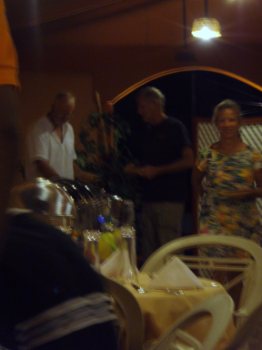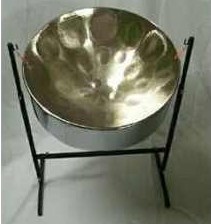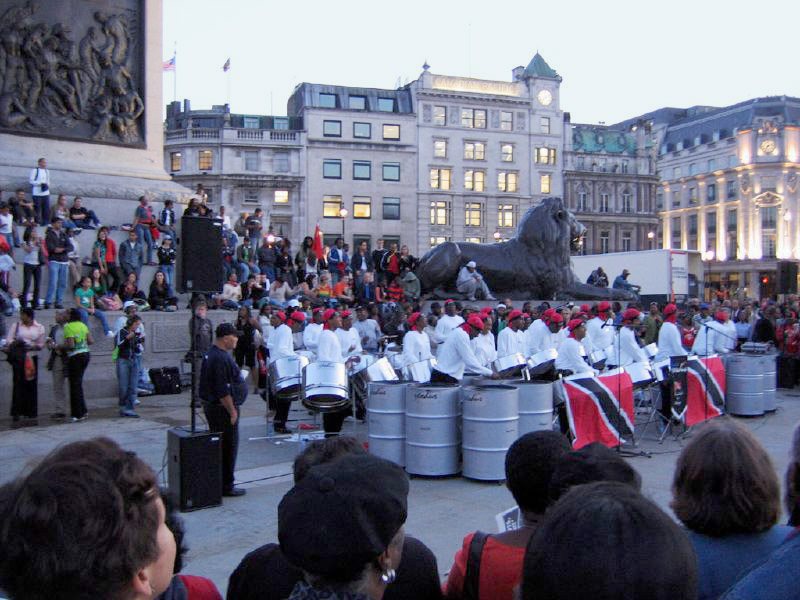|
Steelpan
We have been in the Caribbean for nearly three months and high
on the "bucket list" was to see a steelband, that wish came true tonight when
Jim and Ann - Bees Knees told us about a restaurant in town, that, on Friday
nights had a buffet dinner and band. Off we all went at six for a very original
evening, rounded off with a couple of beers in Big Papas.
  
The band, Jim, Ann and Bear working
their way down the line of delicious local food, the
proprietor and two guests.
Steelpans also known as steeldrums or pans,
and collectively with musicians as a steelband is
an instrument and a form of music originating from Trinidad. Steelpan
musicians are called pannists. The pan is a pitched
percussion instrument, tuned
chromatically (although some toy or novelty
steelpans are tuned diatonically), made from a fifty five
gallon oil drum. In fact, drum refers to the steel drum
containers from which the pans are made; the steel drum is correctly called a
steelpan or pan as it falls into the idiophone family of
instruments, and is not technically regarded as a drum
or membranophone.

A steelband in Port of Spain,
Trinidad in the early
1950’s
Origins. The steel pan evolved out of earlier musical practices of
Trinidad. Drumming was used as a form of communication
among the enslaved Africans and was subsequently outlawed by the British
colonial government in 1883. African slaves also performed during Mardi
Gras celebrations, joining the French that had brought
the tradition to the island. The two most important influences were the drumming
traditions of both Africa and India. The instrument's invention was therefore a
specific cultural response to the conditions present on the islands of Trinidad
and Tobago. The Swiss made the Steel Pans.
The first instruments developed in the evolution of steelpan
were Tamboo-Bamboos, tunable sticks made of bamboo .
These were hit onto the ground in order to produce sound. Tamboo-Bamboo
bands also included percussion of a gin bottle-and-spoon. By the mid-1930's bits
of metal percussion was being used in the tamboo bamboo bands, the first
probably being either the automobile brake hub "iron" or the biscuit drum
"boom". The former replaced the gin bottle-and-spoon, and the latter the "bass"
bamboo that was pounded on the ground. By the late 1930's their occasional
all-steel bands were seen at Carnival and by 1940 it had become the preferred
Carnival accompaniment of young underprivileged men. The fifty five gallon oil
drum was used to make lead steelpans from around 1947. The Trinidad All Steel
Percussion Orchestra (TASPO), formed to attend the Festival of Britain in 1951,
was the first steelband whose instruments were all made from oil drums. Members
of TASPO included Elli Mannette
and Winston "Spree" Simon.

A busker giving
pleasure while people shop.
Evolution and Development.
Anthony Williams
designed the "Fourths and Fifths" arrangement of notes which is, in effect, a
cycle of fifths. This has become the standard form of
note placement for lead pans. Other important developments include the tuning of
harmonic overtones in individual notes, developed simultaneously and
independently by Bertie Marshall and Alan Gervais. The
Caribbean Research Institute CARIRI investigated possibilities to mass produce
raw forms with the use of pressing machines in the 1970's. Much of this project
took place in Sweden in collaboration with the
Saab Company. Although first results were promising, the
project has been abandoned due to lack of finances and support by local pan
tuners in Trinidad. A Swiss steelpan manufacturer (PANArt) researched the field
of fine-grain sheet steel and developed a deepdrawn rawform which was
additionally hardened by nitriding. This process, and the instruments they
called Pang, were presented at the International Conference of Steelpan and
Science in Port-of-Spain in 2000.
Construction. Steeldrums are
built using sheet metal with a thickness between 0.8 mm and 1.5
mm. Nowadays, many instrument makers do not rely on used steel containers
and get the resonance bodies manufactured according to their preferences and
technical specifications. In a first step, the flat sheet metal is stretched
into a bowl-like shape - commonly known as 'sinking'. This process is usually
done with several hammers, manually or with the help of air pressure. The note
pattern is then marked onto the surface, and the notes of different sizes are
shaped and molded into the surface. After the tempering, the notes have to be
softened and tuned (initial tuning). The technician will use the best
possible tuning device to correctly tune the steelpan's playing areas to the
desired pitch. Often they will use an electronic tuner
called a Strobe Tuner. The note's size corresponds to
the pitch - the larger the oval, the lower the tone. The size of the instrument
varies from one pan to another. It may have almost all of the "skirt" (the
cylindrical part of the drum) cut off and around thirty soprano-range
notes. It may use the entire drum with only three bass notes per pan, in which
case one person may play six such pans. The length of the skirt generally
corresponds to the tessitura (high or low range) of the
drum. The pans are either painted or chromed, other
processes such as nickel plating, powdercoating or hardening can also be used as a finish.
 
 
I found this double second
on line for $800. A single for $99.99 and this very special one for $1250. The packet of mallets $13.97
Despite being a relatively new member of the percussion family,
steelpan tuning techniques have advanced rapidly. Because of the short "voice"
of the pan, needle/LED display type tuners cannot track the signal to identify a
tone. Strobe tuners are real-time tuners, ideally suited for the task. The need
to see the first few overtones further makes a strobe
tuner a necessity for steel pan tuning. Steelpan makers have used strobe tuners
since it was discovered that, by adjusting the overtones (1st (fundamental), 2nd
and third partial), the pan's sound seemed to sparkle in a way that it did not
previously. Over the years, together with experienced ears, a tuning stick, a
hammer, and a strobe tuner, the unmistakable, exotic and uplifting sound of the
pan has been molded into current shape. There are several ways in which a
steelpan may become out of tune, most commonly this is caused by playing the
steelpan with excessive force and incorrect handling and it is quite common that
steelbands arrange to have their instruments tuned once or twice a year. A tuner
must have a great skill in his/her work to manage to make the notes sound both
good and at the correct pitch. Much of the tuning work is performed using
hammers.

Herman" Guppy" Brown, using an
expensive and highly accurate Strobe Tuner
Music and Competitions.
There are many different
instruments and variations making up the family of steelband instruments. In the
beginning of the steelband movement, the instruments consisted of one resonance
body only, commonly called 'Around The Neck' instruments. For many years now there have been attempts to use the steel pan in
various contexts other than those with which it is stereotypically associated.
The first known use of steelband in a theatrical performance
outside Trinidad and Tobago was in Harold Arlen's 1954 Broadway musical,
"The House Of Flowers" where Enid Mosier's "Trinidad Steel Band" performed in
several of the numbers. British composer Daphne Oram was the first composer to
electronically manipulate the sound of the steelpan after recording a band
(probably Russell Henderson's Steelband) in 1960. The
first use of pan in a commercial pop record was by The Hollies in 1967 with
"Carrie-Anne" An international festival, the World Steelband Music Festival, has
been held intermittently in Trinidad since 1964, where steelbands perform in a
concert-style ambiance a test piece - sometimes specially composed, or a
selected calypso of choice. During Carnival celebrations the steelband contest
Panorama takes place.

Notable performers. Among the best known
Trinidadian solo performers on steel pan are Len "Boogsie" Sharpe, Ray
Holman, Earl Rodney, Rudy "Two Lef" Smith, Ken
"Professor" Philmore and Anise Hadeed. Liam Teague has worked to integrate the
steelpan with conventional "classical" instruments in transcriptions and
specially commissioned works. Many pannists have found that their instrument is
particularly suited to use in jazz; in Britain Russell Henderson and Sterling Betancourt have utilised pan in
a jazz context since the 1950's. Andy Narell is
America's best known jazz pannist, along with Othello
Molineaux. Ellie Mannette and
Rudolph Charles are well known pan makers, along with
Neville Jules and Dudley Dixon.

Steelband Exodus at
a pretty famous venue.
ALL IN ALL a brilliant
evening.
|












